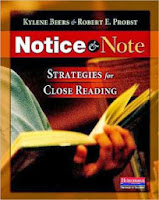In the Curly Classroom, we love us some Kylene Beers! She's all about application and she truly gets the struggle that we face when it comes to teaching kids who are reading well below grade level. Her book When Kids Can't Read: What Teachers Can Do offers lots of fix-up strategies to help teach kids how to understand what they've read and to make inferences.
Her latest book, Notice and Note: Strategies for Close Reading, co-authored by Robert Probst, tackles new common-core standards and problematic issues surrounding those standards and the implications for reading. In the great state of Texas, we haven't adopted the common core standards, but our TEKS do align with one of those problematic issues--a text-dependent approach to reading.
Text-Dependent Reading and Questions
When reading a text depends on a singular, text-based interpretation, kids are left to look to the teacher to see if they have gotten the "correct" answer. The argument is that we've bred an entire generation of children who don't work to fix their own understanding. Instead, they wait for the teacher to tell them what they're supposed to understand. Ouch. *I find this section utterly fascinating, and I could continue to write WAY more, but--true story--Suzanne makes fun of me when my blog posts are too long. If you want to nerd out with me on this, shoot me an email and we'll talk.
So here is how Kylene Beers and Robert Probst suggest we tackle the problem. We show children how to monitor their own reading and how to notice those BIG moments that really push a text forward. There are six "signposts" that the authors have identified that help students to notice important shifts or moments of development. Each signpost comes with questions that readers should ask themselves as they move forward. Here are the signposts:
- Contrasts and Contradictions--a character acting in a way that contrasts with how you would expect someone to act or that contradicts how that character has been acting.
- Aha Moment--a character finally understands something
- Tough Questions--when a character pauses to ask himself or someone else really tough questions, you are getting a glimpse of what's bothering him most and what he will likely struggle with (or come to understand) throughout the story.
- Words to the Wiser--when someone who is older or wiser stops to offer the main character advice or insight, this typically points to a theme.
- Again and Again--repetition is huge and can point to all sorts of things (theme, symbol, character development...)
- Memory Moment--[I'm going to directly quote this one] "When we share a memory with someone, it's usually because that memory has something to do with what's happening in that moment; the memory of the past helps explain the present moment."
You should know that this particular book is centered around reading fiction. In it, the authors allude to a coming release of a similar book centered on non-fiction. Let me tell you--I'm about to rant for a bit. Sorry, Suz.
Fiction is a Big Deal
Somehow a few years ago, English teachers got all crazy and decided that our kids read too much fiction and they know fiction and they don't read enough non-fiction. So we stopped purposefully reading it! For real. People stopped reading fiction and teaching fiction strategies because we said kids know fiction. Guess what. They don't. We may feel like we've taught enough fiction, but we haven't. Think about it this way--what's more fun to read? Fiction or non-fiction? A story about a man who challenges the status quo in his small, southern town and fights a losing fight--or an article explaining racial segregation in the south? Teacher friends, we have to teach fiction. We hook them with it, we teach them to read it well and we give them non-fiction as well. Don't give up on fiction. Pretty please. --end rant
Give Notice and Note a whirl. The questions that go with each signpost ask readers to generate their own questions, which fosters a much more authentic reading experience where kids are seeking their own information, rather than answering a question the teacher asked that they don't really care about. And--bonus in the Curly Classroom--they suggest teaching the signposts with picture books. And they provide titles. And lessons. Love.
